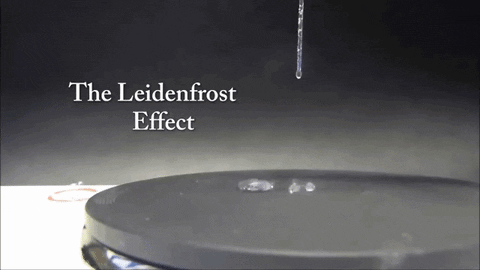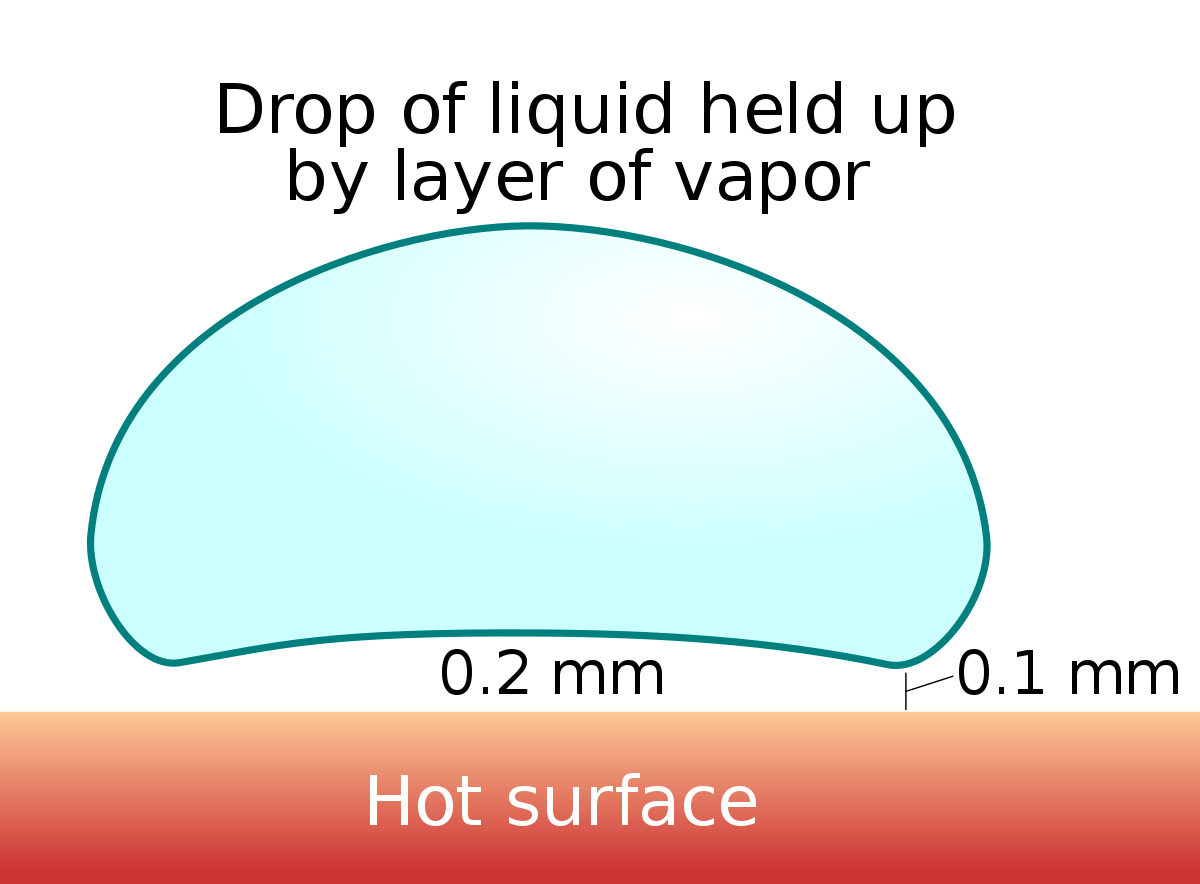- cross-posted to:
- nottheonion@lemmy.ml
- cross-posted to:
- nottheonion@lemmy.ml
Carbon steel or cast iron all the way.
Stainless steel! Neither of those is something you want to use to simmer a tomato sauce.
Why’s that? I’ve never owned any of the 3, all pans have been some form of nonstick.
Carbon steel and cast iron cookware have reactive metal surfaces that will rust if left exposed to moisture and air, especially when heated. To use these materials of cookware you need to season them which involves washing the surface clean and applying a very thin layer of oil which you then heat up to a high temperature (usually past the smoke point, but not strictly necessary).
The heating of oil in contact with the metal causes the oil molecules to polymerize and bond to the metal surface. Done properly, this gives your cast iron and carbon steel cookware a smooth, glassy, slightly brown protective polymer layer which prevents rust and helps foods release (though not as well as nonstick pans). The seasoning process can be repeated as many times as you like and it builds up more and more layers which darken over time. A well seasoned piece of cast iron or carbon steel cookware will look shiny and jet black, though this is not necessary for cooking.
The downside of these materials is that acidic or basic foods can damage the polymer layer and dissolve it right off the pan with enough heat and cooking time. Tomato sauce is a classic example of an acidic food that will eat away at the seasoning of a cast iron or carbon steel pan. A well seasoned pan can still be used to cook a tomato sauce, but not one you plan to be simmering for hours and hours (like some Sunday meat sauce like you’d see in Goodfellas).
Stainless steel (as well as enameled or porcelain coated) cookware is nonreactive so you can use it to cook acidic or basic foods no problem!
Ohh right, I didn’t think about how acidic tomatoes are. I love tomatoes, but some of the people around me get absolutely horrible stomach pains apparently.
Anyway, we make tomato based sauces at home, but never have we simmered anything for several hours like that cooking scene in Goodfellas. Should I? Would it be significantly better?
deleted by creator
It depends what you’re going for. There are a lot of classic long simmered tomato sauces, they are a different thing than fast cooked ones though. Long cooked ones tend to be more mellow and complex, but lose some of the acidic zing, adding a bit of vinegar or wine at the end can bring that back though.
Just don’t make them in a cast iron, not only will the strip the seasoning, they will also absorb some iron, great if you have an iron deficiency, but it can make the sauce taste a bit metal-y.
I thought there, who on earth makes tomato sauce in a non-stick pan 😅
Nice writeup btw!
So my stainless steel/inox Lagostina pan is non reactive? What would be the benefit from having a carbon steel one (I have used cast iron a lot but it’s so heavy)?
Any community you’d recommend?
Exactly that: weight. Some people will give you other reasons why they like carbon steel but the most important is that it works like cast iron only lighter
A well seasoned carbon steel is pretty much non-stick while in a stainless you usually want some sticking to have something to deglaze for sauces.
Mine sticks enough for a nice sauce :-) !
Carbon steel is lighter but this also has less thermal mass, so it heats up and cools down faster, also tends to have less even heating.
So, searing something quickly on a preheated pan is a bit harder since the pan will cool off faster as the food leaches the heat out. Important for stuff like stir fry’s or steaks where you want short periods of intense heat for good searing at the surface but not over cooking in the interior.
I don’t want to cause a panic, but acids like tomato juice, ascorbic, citric and vinegar can attack stainless steel and dissolved chrome in the process.
But don’t think of it as extra chrome in your diet. After all, we get iron rich water from our cast iron pipes and fittings. Nah, think of it as that extra cancer you’re gonna be getting! Iron never gave you cancer, that’s a lousy metal. But chrome is pretty good!
But don’t think of it as extra chrome in your diet.
Aw man…

https://theproperkitchen.com/do-stainless-steel-pans-leach-into-food/
Yes and no, apparently.
Basically go to goodwill and have a look at their used stainless pans and then compare that to what you see at the store. Its not magic material. You put some tomatoes paste or salty beans or vinegar on it and you’ll be getting some chrome dissolved on to your food. Great! Its just a little right? Wrong! What else do you see? Scratches! Every time you use a metal spoon or steel wool to grab food or clean the pan, you create brand new unreacted leachable metal chrome…pans are probably grade 18 or 316 stainless steel, so 18% of whatever shavings you made becomes happy trivalent Cr-3 ions floating around with your tasty Na and CL lol. Look at pans that got overheated or pans where you accidentally left a spoon before going on vacation for a week…they’re black where some food was left on the surface due to oxygen depletion. Stainless steel is by no means the savior. Its the magic bullet, along with plastic in the food processing business! Processed foods pass thru churning mechanisms…metal rubbing and shedding stuff on to the food.
This is why I sleep at night. I’m basically a walking FEMA disaster zone, yet, I still somehow get to my 8hr enslavement work and then back to my rest of the day 2-3 hours worth of family disfunctions just fine.
TLDR: the tomato sauce (and other acidic fruits) reacts with the iron. Although properly seasoning (fat treating) your pan will ameliorate it, and humanity has used it for time immemorial. It does eat away some of the seasoning, leading to having to te season it, which can be annoying.
Sure, or enamelled cast iron.
I just use a aluminum pan. It doesn’t really matter if it heats evenly since you are making a liquid.
Aluminum is reactive too. But it tends to hold onto a seasoning really well!
Not necessarily. You can by pans with a polished surface.
If there is exposed aluminum, it will dissolve readily in to acidic food, polishing or not, and unlike dissolved iron which tastes off but might actually be good if you don’t get enough iron in your diet, aluminum has some toxicity to it, not a huge worry but something to be aware of.
Removed by mod
Used cast iron is usually better than a lot of new stuff. Back in the day, it was common for the pitted surfaces to be ground smooth.
Now you can only get that with some “premium brands” that are willing to take a grinder to a pan before throwing it in the box.
Got a few inherited from my grand and great grand parents, they’re amazing and perfect. Even got a cast iron muffin tin which is great for making Yorkshire puddings.
Buying thrift store cast iron is risky, it may have been used to melt lead.
Fair, but you can get a lead testing kit for around $10 USD.
Sorry if this is a dumb question, but why would you use it to melt lead?
Enameled cast iron is also great
Is this the ceramic coated ones?
Website doesn’t load
I have my browser configured to default to reader mode, and it seems readable
Safeguarding Your Website 🕵️
We’re checking if you’re a real person and not an automated bad bot. Usually, the captcha below will complete itself. If it doesn’t, simply click the checkbox in the captcha to verify. Once verified, you’ll be taken to the page you wanted to visit. Human verification is in progress ✨ Enable JavaScript and cookies to continue
If for some reason after verifying the captcha above, you are constantly being redirected to this exact same page to re-verify the captcha again, then please click on the button below to get in touch with the support team.
I guess they don’t want our traffic then.
It’s unfortunate - I thought it was a fairly comprehensive and readable overview of the differences between enamel and ceramic coated
A bit ironic that a group labeling themselves the “Cookware Sustainability Alliance” is fighting to continue making unsustainable cookware.
Both the fact that they have a voice that influences politicians more than their actual voters and that they’re allowed to call themselves that name is really a perfect representation of society.
Costly but good
Cast iron is cheap at the second hand store.
GenX was basically told that “Teflon is inert, it can’t hurt you.”
Well fuck me.
It is chemically inert. It just becomes a problem when you physically abrade it into billions of microparticles that become embedded in your tissues…
So, asbestos 2.0?
Likely, if we’re being honest.
Health agencies haven’t done that much investigation (wheeeee regulatory capture) into wtf microplastics do in nuance to all of our various biological systems, but we do know that microplastics basically pervade everything at every level of the food chain at this point. So it’s more about answering the question of “how much did we fuck ourselves” now.
Has there been any evidence to point out that PFTE is not inert?
This article seems to be about the production of PFTE, which is well-known to be quite harmful, but the end product is as far as I know not unsafe to use.
Previous formulations were also claimed to be inert and non-toxic, but were later found not to be. Current ptfe seems to be safe so far but at this point I’m really cynical about safety of these chemicals, industry willingness to inflict them on us and ineffectiveness of governments safety regulations. They’re forever chemicals. Even if they are safe, they will be in the environment, in ever increasing doses, forever. They are accumulating in you, your food, everything you ingest, forever. That doesn’t seem prudent.
What are you going to do if a toxic pattern emerges, but you’ve already incorporated ptfe into your body? even if the the end product is safe, manufacturing chemicals are not: do you accept your part in these toxic forever chemicals?
There’s not much an individual can do, but I can replace non-stick with other materials as they grow older. I have cast iron, stainless, glass, or ceramic as appropriate, that we know lasts longer and will not have a problem.
Keep in mind that nonstick cookware is still very safe when handled correctly. The problem lies in the manufacturing of these needed chemicals. When these chemicals get into the environment, because of improper safety management, it will stay there for hundreds of years, taking it’s toll on flora and fauna.
very safe when handled correctly
Too many people are not educated about that.
The problem lies in the manufacturing of these needed chemicals. When these chemicals get into the environment, because of improper safety managemen
Which is one of the reasons for that law, see:
Dubbed “Amara’s Law” after 20-year-old cancer victim Amara Strande, who in 2023 succumbed to a rare type of liver cancer linked to PFAS after growing up near a Minnesota-based 3M plant that dumped them into the local water supply, the new regulation bans the chemicals and any items made with them from being sold within the state.
And how do you dispose of it correctly? Cookware shouldn’t need to come with an MSDS sheet
Wait, it’s not the material on the Pans?
It is the material on the pans, but the only case where the companies making the stuff were successfully sued was when they were caught for dumping intermediates of the chemical in to a tributary of Ohio river.
It’s hard to pin down how impactful the coatings on the pans are because of how many other sources of these kinds of fluorocarbons are in house hold items, and in the environment due to large companies disposing of them recklessly. We know for a fact that basically everyone has some level of these compounds in them due to their ubiquity.
The pans are just one potential source and a particularly notable one because they’re in contact with food.
Does Teflon even break down into PFAS at all? From what I read I think it doesn’t.
PTFE and chemicals used in its production are some of the best-known and widely applied PFAS
Capitalists furious at suggestion they value human life over money
ftfy
yeah it’s a day ending in Y
I think distinctions matter
What a ridiculous world we live in. The board members should be facing prison sentences, the company’s liquidated and the money back to the people.
The money should be put into a cancer fund to pay for research and people’s medical bills from the cancer all this shit causes.
I hate how we allowed these ghouls to make the word “nonstick” synonymous with teflon/PFAS. It makes it sound like if you use a regular pan, you constantly have to scrape off burnt food or something. That’s just not true, a well-seasoned regular pan can be just as “nonstick” as one with a PFAS coating. It’s a fake non-problem that was invented to sell this garbage that poisons us and the environment. If it was up to me, the executives at dupont and anyone else responsible for this psyop would be sent off to labor camps (with humane working conditions of course)
And you don’t even have to use a cast iron. I’ve been cooking on stainless steel for a decade. I chuck it in the dishwasher when I’m done.
And as long as it’s oiled and hot, nothing sticks; not even eggs or fish. Especially if you use butter. But oil’s just fine.
what oil do you use for steel? I find that if I have to make steel hot enough for it to be non-stick, as soon as I put oil on it it starts smoking if it is plant oil or burning if it is fat.
Whatever I have on hand or fit’s the dish.
Mostly rapeseed oil, sometimes olive oil. When I first started (before I was able to just guess), I put a drop of water in the pan. As soon as the water started to boil, I added the oil and was ready to go.
Nothing stuck for quite a while. But if it did, sometimes it was enough to wait a bit for everything to release by itself.
Aside from that: butter. Butter does some magic.
doesn’t the oil burn when you put it on a very hot steel pan or do you have a trick? I guess rapeseed oil burning point is higher but if I put butter on a very hot pan it immediately turns brown and then burns in a matter of seconds.
Maybe you’re just getting the pan too hot? I know that sounds silly but it might be as simple as turning the heat down some and cooking whatever for a little longer.
Or at least that’s like my cardinal cooking sin, I’m always getting the pan too hot and burning shit unless I’m very careful to think about it.
but you are supposed to heat the steel pans until water kind of jumps in it (to make it nonstick) and that much heat generally already burns the oil I am using…
And if you heat any oil too much it starts producing carcinogenes. Butter is especially prone to do that even in relatively lower heat if it’s not ghee. So it becomes toxic in a similar way as teflon is.
Can’t really cook this way oil-free though. I roast my food in a toaster oven, on a parchment paper-lined baking sheet. Took some getting used to, but I find it more convenient too.
deleted by creator
Heart disease and diabetes are very prevalent in my family, so I generally try to keep my diet in the direction of the Esselstyn guidelines. I’m currently not entirely strict about it, it’s a work in progress.
Admittedly the science of added oil vs no oil is very much an open question still, and much more studies need to be done to see if Esselstyn’s relatively extreme restrictions truly make a real difference. Still, it’s a safe diet, it’s designed by heart specialist specifically for treating heart disease, and from what I’ve seen it appears to be the most promising option out there. Also, if it ever does become proven that atherosclerosis can be reversed - particularly through lifestyle interventions - I think that’s really cool and exciting.
As a sidenote, for general populations, Harvard currently has the strongest evidence supporting the idea that a little oil is fine, as long as you’re choosing the right ones.
I’m sorry that is something that you have to deal with while cooking.
I’m glad that you have a plan and stuff to mitigate it.
Thanks, but I wouldn’t say it’s something unique to me. If you look at the top 10-15 causes of death, Heart disease is generally number one. On top of that, many of the other top causes are diet-related diseases as well. In other words, diet is arguably the number one cause of death and disease in industrialized nations. I just think it’s sad that so many people suffer their whole lives and die prematurely from causes that are so very preventable.
You might actually not be better off with parchment paper, it is nonadhesive thanks to fluorinated compounds (PFAS) or silicone in most cases
This is what I get:
Good to hear, those are silicone based as far as I know. Not totally risk free but much much better than the alternatives.
Issues with food sticking to either a stainless, carbon steel, or cast iron pan, largely come down to technique and maintenance.
So if you’re going out to buy a teflon pan you’re admitting that either you’re a bad cook, or you’re lazy…. Or both.
Is it really that bad? Sure it might be linked to cancer but so are lots of other things.
I personally just use normal cookware plus some vision stuff. All you need to do is salute some onions ahead of adding other things. The juice from the onions acts as a natural non stick.
🧅 🧅 🫡
I also want to salute my fellow onions 🫡🫡
Doing god’s work
I mean when there’s a fun little joke to be made, and I can post emoji-only rather than the usual text-only and my fellow nerds will like it, AND we’re in nottheonion which I didn’t notice until afterwards, how can I resist?
in the produce section thank you for your service
You made me laugh, have an updoot
The updoot-to-text ratio is off the charts with this comment, lol.
How we start the day off under this roof
In reality no one can say for certain, but a lot of research is pointing to long term exposure being bad. The problem is that the research to determine how bad will take decades (and has been going on for decades at this point). Right now it’s being used as the boogeyman for every sort of ill from causing cancer, infertility, issues with lactation, liver failure, high cholesterol, thyroid disease, and auto-immune disorders. Basically the preliminary research says that it at least in part impacts all of these things, we just don’t know how much.
On the flip side bacon also causes cancer and high cholesterol at some level. That’s not to make light of the situation, but it does give some credence to your earlier statement.
The thing people are missing in these discussions is what are they willing to live without if we don’t use these chemicals. Going without non-stick cookware is literally the tip of the iceberg. How do we feel about cars, furniture, and mattresses being more flammable because they don’t have the fire retarding forever chemicals? How do we feel about stain resistance, oil resistance, water resistance, and slip resistance in everything including shoes, umbrellas, clothes, oven mitts, jackets, and more? How do we feel about needing to clean everything including clothes, appliances, and floors more often. How about in industry where it’s used as a fume suppressant so smelly chemicals don’t waft as far or fire fighting foams the next time an electric car catches on fire? This stuff is even in the wrapping of your food so the it doesn’t go through the packaging and cause a mess as easily.
Dupont coined the phrase “Better Living Through Chemistry” and that chemistry is PFAS. It’s in your clothes when you buy them, it’s in your detergent when you clean them, it’s in the cleaner that you wipe your washer off with, it’s in the floor sealant of the laundry room that washer is in, it’s in the gloves you wear while cleaning that laundry room, it’s in the carpet in the room next to the laundry room, and the list goes on and on.
Dropping PFAS chemicals fully would probably send us back to the 1960’s or we’ll end up replacing it with something just as bad that we don’t know the effects of yet.
It’s not just the use itself, but also how irresponsibly it is produced. Exposing pregnant workers to high levels, dumping it in community water supplies, on farmland etc.
Also the EU did ban them last september (effective in 2026) for essentially all of the uses you outlined, most of which I dont think are such a big deal and just minor inconveniences. It’s not like the 60s were terrible in terms of living conditions.
We also used to use asbestos for a lot of the uses you outlined and we got rid of that without too much inconvenience, but you could have made similar arguments about it back then.
And any reduction is a good thing, it’s not an all or nothing thing. DDT was banned, but can and is still used where there’s no better alternative. And just categorically saying any alternative must be just as bad is just a non-sequitur, there’s no reason that should be true. Cookware is a good example, cast iron works just as well, is not as bad, the only downside compared to teflon is weight. But it’s not like sending us back to the stone age or anything…
And just categorically saying any alternative must be just as bad is just a non-sequitur, there’s no reason that should be true. Cookware is a good example, cast iron works just as well, is not as bad, the only downside compared to teflon is weight. But it’s not like sending us back to the stone age or anything…
You can have your own opinion here, but anything which performs like PFAS compounds, in the variety of uses that PFAS is used, will almost certainly be bad. In general when you make new compounds and materials which are more complex their potential health impacts are worse. PFAS is already an extremely complex material and while broad sweeping statements might not be 100% accurate, I wouldn’t bet that it’s replacement would be better for people.
It’s another thing altogether if you are recommending going backward in the development chain, cookware is a good example here but it’s limited case underlies the ubiquity of PFAS. Hell, PFAS is a major component in computer part manufacturing and is part of the reason computing technology has progressed as it has.
It’s in the rain and every freshwater fish or lake water has it, such that even once per year fish consumption is not recommended. Safe level is 4.4ng per kg body weight/week. 300ng for adult male. Half kilo of fish will be 4800ng. Technically that is 3 fish portions per year, but you will get enough smaller amounts every day to breech limit with freshwater fish.
You have a point that it may still be needed for some stuff.
Source for once per year fish consumption? I couldn’t find that.
You can’t have it needed in some stuff and critically dangerous if it’s a bio-accumulating chemical that virtually never breaks down. To reduce it enough to not be a hazard world wide you would functionally have to stop using it everywhere.
I haven’t seen any definitive results on dangerous health levels, 4.4 ng/kg might be it, but then other studies show people with mg/L of blood concentration. Overall the effects of exposure seem to depend on more than just the concentration, such as health status, exposure duration, magnitude of exposure, and how lucky you got with the genetic lottery. Even then we are fairly certain it is bad, we just don’t know what or how specifically. I would also throw caution at any study using ng as a serious measurement here, especially over prolonged exposure. The problem with measuring on such a low level is that you have far too much uncertainty to claim any true accuracy, at best these studies are guessing when they throw out numbers. Hell, the EPA just came out with a standardized method for analyzing PFAS last year.
At those levels of exposure you’re probably getting it just from eating commercially grown fruits and vegetables, because it can bio-accumulate in those as well.
other studies show people with mg/L of blood concentration
4.4ng/kg per week was the result from google “safe pfas levels”. 46 weeks gets to 1 mg.
Um, no it doesn’t… maybe you’re confusing micrograms for nanograms?
How do we feel about having 8g of plastic in our brain. Each of us. https://pdfs.semanticscholar.org/cef0/fd3b2409e2ef92182d9fc42e4308d5fe1b2b.pdf
I don’t have a lot of thoughts on the matter, I know a good bit about PFAS, not microplastics. Grams vs Nanograms is a huge difference, but I don’t know if that’s detrimental or not. Looking over the link you provided the study provides it’s own description of limitations which may or may not be trivial.
Yes. Get as far away from that shit as you can.
This article is horrible. Anyway…
Teflon has a melting point of 327°C, that can happen on a stove.
IMO It’s fine, just don’t burn your pan. Not sure about scratching it, but don’t do that either.
it seems like the primary concern of the article is the waste from producing it, not its usage
I’m not sure you need to melt it for the PFAS to leech out. There was a study recently about smart watch bands and they found that the PFAS exposure from wearing them was way above safe limits and they weren’t being heated to 327C.
Admittedly frypan coatings and watch bands are not the same materials, but still…
So, just don’t do the two things that happen to every non-stick pan ever. Gotcha.
Yeah has no one seen the horror show that is the used pan section of a thrift store? More flaking than a millennial get-together.
It’s perfectly fine so long as none of the coating gets in your body, but given you’re making food with it, there’s a high chance it will.
If it get’s too hot it will off gas, if it gets scratched with something harder than it (like a metal spatula, or salt grains) it will flake off. So you should use plastic or wood utensils when cooking in one, and the black plastic utensils have their own issues with often being made from recycled plastics that have fire retardants mixed in, which can leach out.
You can be safe with them but it requires you be careful and deliberate with use. Personally, I think it’s easier just to use something else, even if that means taking the time to learn about how to use them well.
I never use anything but wood and plastic so it is probably fine
Cast iron ftw!
Carbon steel is lovely too.
Doesn’t work too well with induction stoves in my experience. Difficult to season, since it doesn’t get heated evenly. Fine if you have a gas stove tho!
Then season it in the oven.
My mom has like “chemophobia” is is constantly afraid medications or “GMO”. Well looks like she got this part right tho, she was always afraid of a non stick stuff chipping off and hate any “non stick” cookware. Broken clock, twice a day, ya know.
Medications
Sometimes worse side effects than the thing it’s trying to cure. Sometimes used to cure something that better diet and more exercise could take care of. Made by companies more concerned with money than your health outcomes. What’s to be afraid of?
GMO
Nothing wrong with GMO itself, but every company using GMO doesn’t use it to make food higher quality or taste better. They use it to engineer pesticides into your food, increase crop yields, and patent our seeds, for, you guessed it, money! Insecticides specifically can be neurotoxic to humans. What’s to be afraid of?
Maybe you should listen to your mom instead of badmouthing her to strangers on the Internet.
Maybe you should listen to your mom instead of badmouthing her to strangers on the Internet.
So like advice like “antidepressants are bad and it’s all in your head”? 🤔
Ha, probably not that advice.
I haven’t seen anything that actually links GMOs to something that is a concrete negative. There are so many claims that “artificial” and GMOs are somehow bad but yet people can’t seem to quantify why or how.
I think it is mostly just marketing fluff. What’s worse is that the so called “organic” produce is almost certainly worse for the environment. Also some of the “natural” pesticides are worse for humans if actually consumed.
Yeah I agree organic pesticides are just as dumb. Bioengineering pesticides into your food takes the cake though, you can’t even wash it off. Not all organic growers use organic pesticides. I know several organic farmers and none of them use any pesticide, they accept the lower crop yield for higher quality food.
You absolutely should be using pesticides. You are just wasting resources if you don’t. We need fresh food to be cheaper and easily accessible.
There are other ways to grow high yield food without using pesticides if that’s your primary goal. Like indoor vertical farming in a controlled environment. Recently some growers have proven this is viable and profitable. Pesticides in any form are bad for the soil, bad for our health, and decimate the bee and bug populations, which fuck with the ecosystem. Wasting resources includes our natural resources, which are our biggest asset.
Never really had any issue with Teflon (and Teflon substitute) pans, but I’ve been impressed with the non-stickiness of my dirt cheap “ceramic” wok.
Ya know I finally got myself a cast iron pan and it works great!
The issue is that we don’t have much research on the ceramic coatings ether. They might be fine, but, there hasn’t really been enough testing to know. We might just be walking in to the same problem all over again, fluorocarbon coatings seemed fine at fist to, then they turned out to be a huge problem.
I’ve found that the ceramics lose their non stick quality at around the 2 year mark
All real nonstick cookware is Teflon or chemically related to it. I almost always use cast iron or carbon steel but they are not nonstick, you have to control heat and acidity for them to release well. You can even see in nonstick pans that liquids will tend to bead up and not spread out because of the surface, versus in any other pan you’ll only see water bead up when you hit certain temps. I can only achieve something like a French omelette in a nonstick pan, carbon steel has always been a disaster, because of that me and a lot of other people keep a nonstick around just for certain egg and crepe recipes.
you’ll only see water bead up when you hit certain temps.
Basically If you FIRST heat up your stainless steel cookware to the point that when you drip some water on it, it “beads up” instead of immediately boiling away, your cookware becomes temporarily non-stick. Just don’t want to go a lot hotter than that, or you’ll do things like burn butter (unless using Ghee butter or something with a higher “smoke point”)


Wikipedia makes it sound like not all Teflon pans require PFOA, which is the actual problem here (not that the article describes it clearly).
https://en.m.wikipedia.org/wiki/Non-stick_surface
PFOA/PFOS is in lots of other household shit though, like raincoats
Those who cannot cook use not stick.
But they cannot cook, what are they doing with pans. Are they stupid?
I just like nonstick for easy cleanup. Also they make teflon-free nonstick pans. My grandma has some.
More like those who aren’t taught how to use carbon steel, cast iron, and ceramics.
Just clean your cookware people
What if my cookware isn’t people and just metal pans, do I still have to clean them?
I use Greenpan, a ceramic nonstick pan
I was shopping around for nonstick pans some months ago, and exhaustively looking to see if any of them were free of pfas and other toxins. By the end I was nearly pulling my hair out because they pretty much are all bad, including Greenpan. I no longer have the variety of sources I found back then, but here’s one source on them (mind you I wouldn’t necessarily trust this site’s recommendations either).
https://www.leafscore.com/eco-friendly-kitchen-products/why-we-no-longer-recommend-greenpan/
Good to know, thanks for the link. I’ll be sure to check out the top picks in the article
You’ll want to do more research from multiple sources. My memory of it is hazy, but I think I remember the enameled cast iron sets being relatively the best option (albeit expensive), but the biggest thing I remember is every time I would find one source saying brand [a] was the good one, it wasn’t long before I’d find another source saying that tests showed the same brands had toxins in them. It’s an exercise in frustration.
It really boils down to what are you’re willing to tolerate and how much do you want to spend. Unless you want to go copper/stainless/cast but even those probably leach something into the food, and can be difficult to cook with. We need to invent the Star Trek replicator
Same! I love my Greenpans.





















